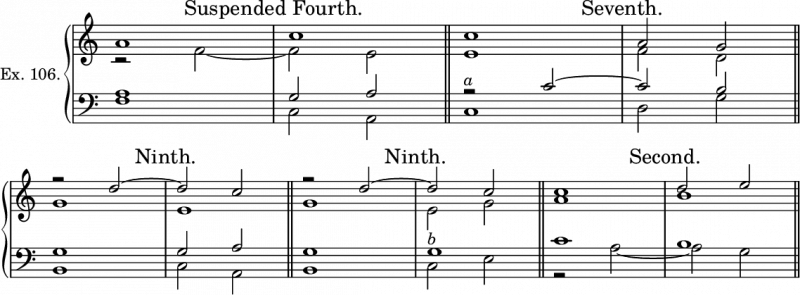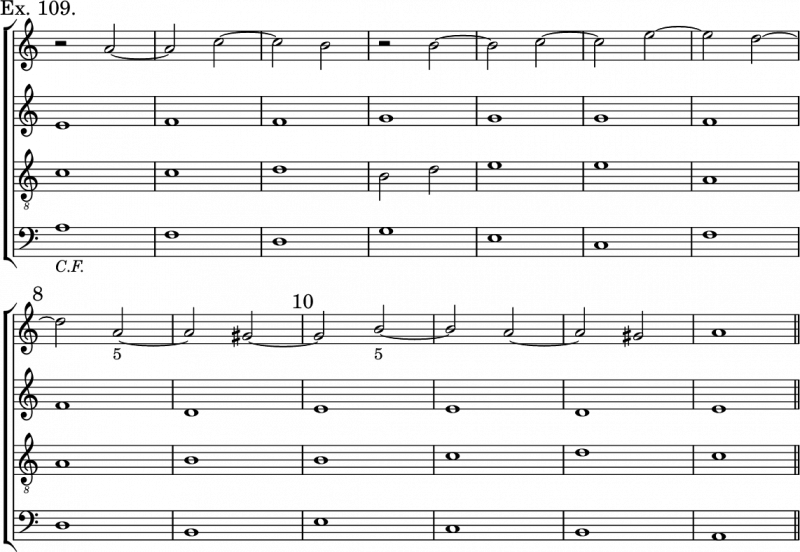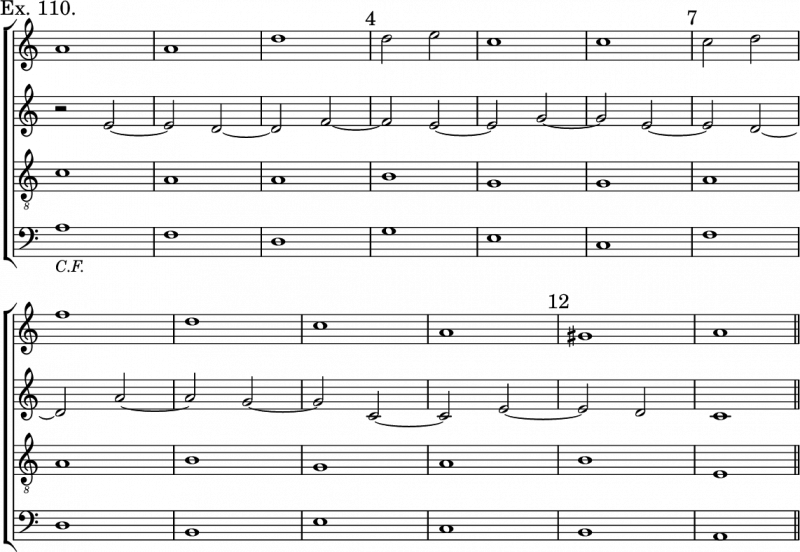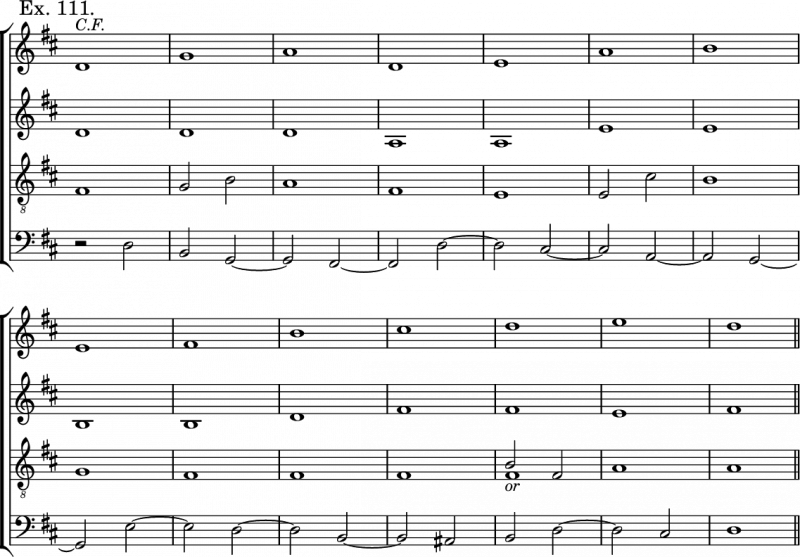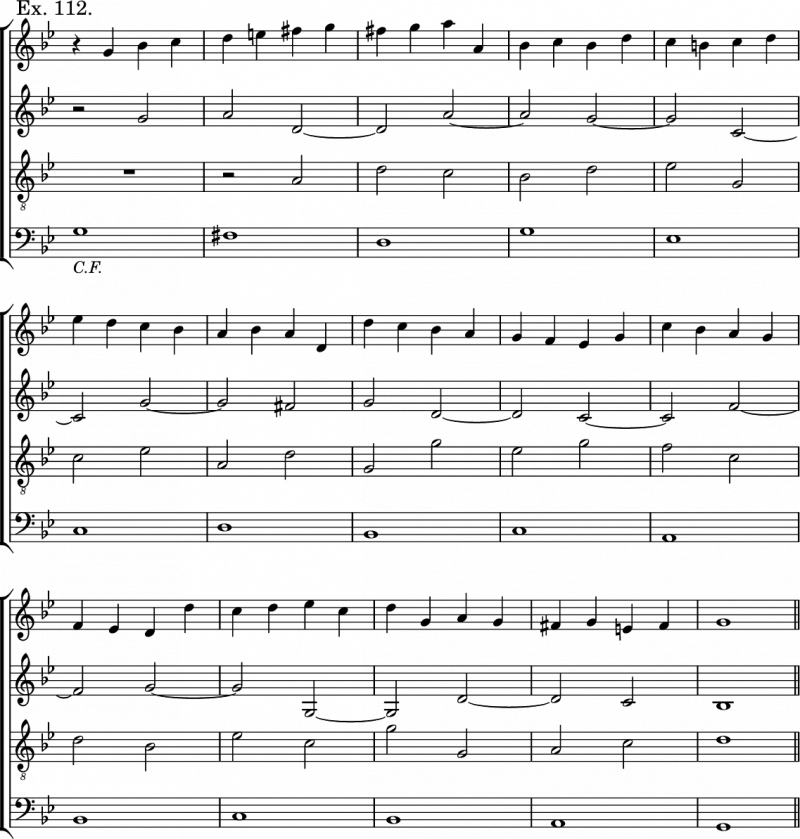Counterpoint (Bridge): Chapter 12
Fourth Species in Four Parts
Syncopation
Rules 1-5
In this species, every chord should, if possible, be complete. What was said at the beginning of Chapter 9 as to the appearance of a note delayed by a suspension, in another part, during the suspension, must be carefully borne in mind 1).
The dissonances and their resolutions are the same as in the corresponding species in three parts. An additional accompanying note will of course be required.
The fourth will be accompanied by the fifth and the octave.
The fifth (as a retardation) by the third and octave (or two thirds).
The sixth (as a suspension) by the third and octave (or two thirds).
Rules 6-11
The seventh by the third and octave; sometimes by a third and fifth, the latter being removed when the seventh falls to the sixth.
The ninth by a third and a fifth.
The second (which can only occur in the bass) will be accompanied by two fifths or two fourths; or the upper note of the two, forming the dissonance of the second, may be doubled.
The fourth is sometimes accompanied by a sixth or octave, being a suspension of the third in a chord of the sixth.
The ninth is sometimes accompanied by a third and sixth, being a suspension of an octave in a chord of the sixth.
The use of the fifth to accompany the seventh necessitates the use of the second species by the part which has the fifth. This interpolation of a bar of the second species instead of the first is often resorted to in the accompaniment of other chords in four-part counterpoint. It is a valuable license, and - when carefully used - makes the harmony much more satisfactory. By the aid of this rule, although a suspension must always resolve upon the note suspended, yet this note (by the bass, or some other part or parts, moving in minims 2)), will often form part of a different chord from that on which the suspension was originally constructed. Sometimes it will resolve on an inversion of the same chord (Ex. 106, b).
The following examples are principally from Cherubini:
It will be seen the example at a is not constructed on a cantus firmus. For a longer specimen, see Ex. 128 in Chapter 15.
In all the above examples, except the one at a, it will be observed that the suspensions are accompanied by the notes belonging to the chord which is really suspended, and not by notes belonging to the chord on which the suspension here resolves.
The discord 3) of the minor seventh may, however, be accompanied and resolved as in Ex. 107, giving us actually a dominant seventh with the usual resolution.
The discord of the second is also sometimes made to resemble the third inversion of a chord of the seventh 4). This is by the addition of a sixth to the fourth and second, which usually complete the harmony accompanying this suspension, thus:
The discord 5) of the diminished fifth may be used in this species of four-part counterpoint when it is combined with a sixth, forming the first inversion of a dominant seventh. It should be prepared and resolved as at c in Ex. 108.
The different species may be combined as in three-part counterpoint. (See Ex. 112.)
Musical Examples
The student will remember that the syncopation may be broken, as in bar 4 of the above example, by a rest (as was described in Chapter 9) 6). The hidden fifths in bars 8 and 10 may be allowed; the former, because there is no real change of harmony between bars 7 and 8; and the latter, because of the sequence between the extreme parts (bars 8-11).
In bars 4 and 7, the second species is introduced in one of the parts accompanying the syncopation, avoiding awkward skips and improving the harmony. In bar 12, the third in a chord of the sixth is suspended by a fourth.
The second, third, and fourth species are combined here. Many licenses are of necessity allowed under these circumstances, although this example is tolerably strict.
| Navigation | ||
|---|---|---|
| « Chapter 11 | Contents | Chapter 13 » |
